Quote
Art and philosophy are two different practices... I guess what they have in common is to work on the rim, on the edge, there where there are still unknown lands and oceans.
Sarah Burger
#contemporary art#artist quote#sculpture#printmaking#philosophy#borders#edges#temporality#Architecture#ecology#installation
2 notes
·
View notes
Text
148. Sarah Burger

Sarah Burger, ‘New Continents (blue), 2017. Digital print on fabric; 190 x 260cm. Image courtesy the artist.
Swiss artist Sarah Burger discusses the work made for her current solo exhibition at VITRINE, London, her first in the UK. With an onus placed on the materiality of sites and architecture, Burger uses physical spaces as the jump-off point for her process-led investigations. Combining two-dimensional and three-dimensional elements created using both analogue and digital techniques, Burger develops complex works which make reference to the topics of presence, duration, time and the history of material.
Your practice has a large focus on architectural spaces, often the social spaces of cities. What is it about these sites that drives your practice and piques your interest?
I'm interested in the sculptural presence of architecture, in its’ time and endurance through time. I understand this world as an ongoing sculpture, an ongoing transformation of interacting entities, non-human and human ones together.
The materiality of architectural structures (mainly stones in ancient times, more recently iron, steel) makes them last and degrade over a long period of time. Whether you look at an urban or a country landscape, it's presence is always a coexistence of different times and duration of this.

Sarah Burger, ‘New Continents (pink), 2017. Digital print on fabric; 210 x 240cm. Image courtesy the artist.
The work created for 'New Continents, Light Lines' was created with the unique architecture and positioning of VITRINE in mind? How did you utilise and contextualise the space?
The VITRINE space is a demanding one, one that doesn't please a possible white-cube desire of anonymous interior walls. The space itself is an entity with which I somehow worked - although from a distance. Besides its unwieldy dimensions, which intrigue me, it was also the fact that it is embedded in a public situation that made me think around the tension between its’ limited exhibition area and its’ actual site-taking presence. The shows at VITRINE happen outside. It's not given where the exhibition starts, you can see it from far away when you walk towards the square. People who work or live in the buildings around see it when they look out of their window. When there is the market on the square, the VITRINE becomes the background scenery of a daily life situation.
The wide format of the vitrine is cinematic. The process for ‘New Continents, Light Lines’ was to find and evidence how my practice can add something to the given situation of the gallery. I often work with material processes, with raw materials like soil and stones and chemical reactions between different colour qualities, which I then enlarge by digital means of image generation. The result of this process is a series of large-scale prints, each showing something that might remind of a cross section through a continent, somehow the hidden parts of a mass of land.
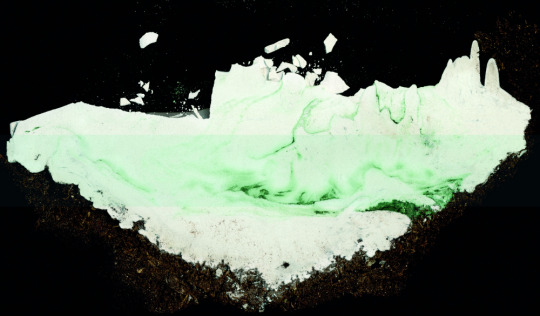
Sarah Burger, ‘New Continents (green), 2017. Digital print on fabric; 190 x 260cm. Image courtesy the artist.
Having read a little of how you describe your work, there seems to be a consistent anthropomorphism of the spaces you are working with and around. Is this a conscious decision? Do you feel that this way of relating to, and accessing the space, effects the dialogue created by the work?
I do not see it as anthropomorphism but rather as encountering others and collaborating with spaces and materials. As I said above, I understand them as entities, as things, as beings with which I join for the duration of a work. Each space, each matter, has its’ own forces; abilities, restraints and idiosyncrasies, which do have an influence on the work, of getting to the resulting work.
Your works appeared to me to act as relics of the materiality and history of the site; markers combining the various understandings of the spatial; the spiritual confronting the temporal. How do you feel about this reading of the work?
Language is such an enigmatic matter that allows endless combinations. Sometimes I do encounter combinations of words that do open up a new space, a surprising glimpse into a different velocity accompanied by a somehow physical impression. "The spiritual confronting the temporal." If someone creates such a glimpse with words accelerated by my works I feel acknowledged.

Sarah Burger, ‘New Continents (light blue), 2017. Digital print on fabric; 85 x 240cm. Image courtesy the artist.
Alongside Fine Arts, you have studied Philosophy, Comparative Literature and Linguistics. Your answer to my previous question touched briefly on your relationship to language. Do you feel that these areas of your education have had an impact on your practice? If so, in what way?
Art and philosophy are two different practices. They are both reflexive but with different means and decisions. One creates worlds, the other one reflects and argues conceptually relations within this world. I guess what they have in common is to work on the rim, on the edge, there where there are still unknown lands and oceans. Some philosophical texts, concepts and ideas accompany my artistic practice in an associative way. They became part of how I live.
Literature is one of the arts, but studying literature means to work with works of art in a scientific way. I got to know a wide range of great texts, but I never felt completely comfortable with analysing literature. Still, I learned some interesting skills for how to work with a text. In the meantime, writing became part of my artistic practice.
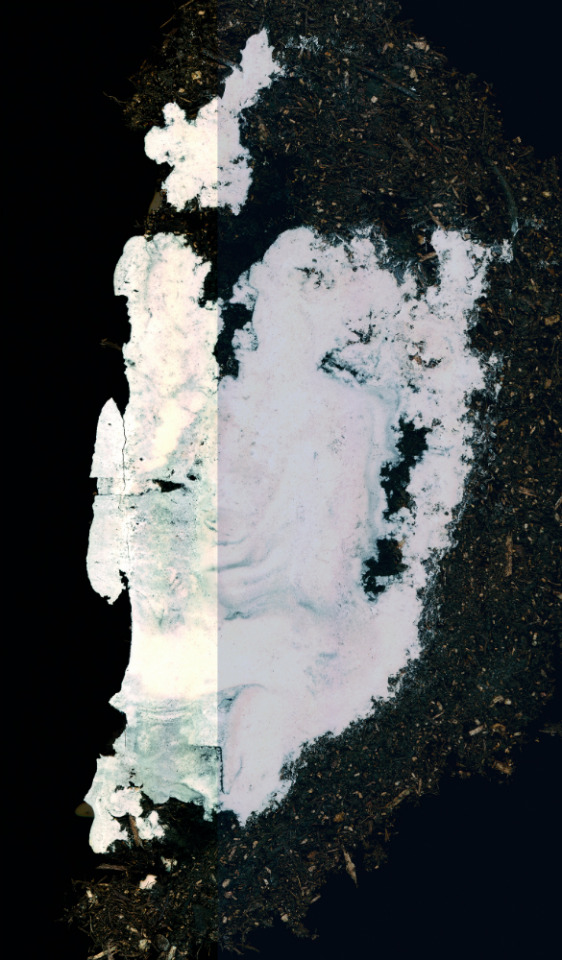
Sarah Burger, ‘New Continents (violet), 2017. Digital print on fabric. Image courtesy the artist.
I was wondering about the level of agency you give to your materials. You have already mentioned that your materials influence the work, how far do these material investigations determine the outcome? Is there any point where you have to delay or recall a process-led decision?
It depends on the works as to how far the chosen materials determine the outcome of the work. The "New Continents" which are now shown at VITRINE gallery are based on gypsum and pigments which I mixed. The structures they created together were their own process. After that, I continued the work in a very determined way.
However, for example in the work ‘(un)earthed’ I buried nine objects made out of degradable fabric in nine different places and unearthed, observed, photographed and buried them again every two or three weeks. In the meantime, all the nine objects have disappeared. In this work, I did decide a lot of things, for instance how I want the photographs to be and how I write as part of the work. But all that I could only decide on the base of what the objects in their surroundings, in their earth, with their mushrooms and insects did and were doing.

Sarah Burger, ‘New Continents (red), 2017. Digital print on fabric; 255 x 280cm. Image courtesy the artist.
You stated that you see the world as "...an ongoing sculpture, an ongoing transformation of interacting entities, non-human and human ones together". It brought to mind current discussions regarding the Anthropocene, in particular how our human-centric actions and thinking regarding the world has impacted upon it. Do you see your work as participating in this dialogue?
I see my work in a contemporary neighbourhood to these thoughts. We live in the same world with and around the same information, knowing about human influence and dependency. But as I said above, conceptual reflections and artistic ones are different practices.
My work is neither an illustration of contemporary concepts nor do I use them to explain my work.
I find it interesting that you take the three-dimensional and, with your prints, render the essence of that space into a two-dimensional form. Could you talk more about why you choose this mode of production?
Indeed, each continent is a scan of an object, but this is also, in geography, archaeology and also tomography, how you look into an object.

Sarah Burger, ‘New Continents (light green), 2017. Digital print on fabric; 210 x 240cm. Image courtesy the artist.
I loved how you referred to the prints for VITRINE as being reminiscent of "...the hidden parts of a mass of land". Would you say that your engagement with materials and spaces is a romanticisation of the hidden and quotidian?
Romanticism is often naively connotated, but indeed I'm very interested in the period of Romanticism as the period that follows the Renaissance.
First, the world was measured, objectively described and investigated, and then followed by a period of imagination, creative introspection and invention of worlds. These two intentions are not something contradictory to me but rather two intensities of the same vitality. In my practice both aspects of this force are important. During the process of making a new work, sometimes one is more present and then again the other.

Sarah Burger, ‘New Continents (petrol green), 2017. Digital print on fabric; 380 x 115cm. Image courtesy the artist.
I'd like to go back to something you said earlier: "Whether you look at an urban or a country landscape, its presence is always a coexistence of different times and duration of this". Could you expand upon your interest in this? In particular, I'm intrigued by the way you view the relationship between temporality and materiality.
If you look at a rural landscape with trees, then these trees have a certain age. You see rocks which were formed millions of years ago. Probably, you see the trace of an airplane in the sky and a plastic bottle somewhere thrown away. The origin of this plastic material is the oil of this planet, organic waste from the time of the dinosaurs and earlier.
In a city, you look at buildings that are made out of stones and concrete. The technique of making concrete goes back around 10'000 years b. C. First traces were found in Turkey. The plants in a modern office building often come from tropic areas, for example, the rubber trees. Where they naturally exist they are huge, beautiful trees that grow over a long period of time.
Right now., I’m sitting at the airport answering your questions. I look at the stone floor in order to find some ammonites. In this specific floor, I can't find them, but they often can be seen in airport floors, in Miami for example and also in certain areas of the Zurich airport. It's been a pleasure answering your questions. I’’m going to go and grab a coffee now, this old Ethiopian drink.
Interview by Charlotte Barnard.
‘New Continents, New lines’ is on view at VITRINE, London until 3 September 2017. More information here.
To see more of Sarah’s work and keep up to date with her upcoming shows, please follow: http://sarahburger.ch/
#contemporary art#artist#sculpture#printmaking#screen print#process#temporality#materiality#philosophy#language#ecology#Architecture
0 notes
Quote
...we are continually occupying hybrid spaces, where people are simultaneously off and online, using objects that are technologically attached and detached
Stine Deja
#contemporary art#artist quote#technology#virtual#irl#annka kultys#stine deja#royal college of art#affect#connection
1 note
·
View note
Text
147. Stine Deja
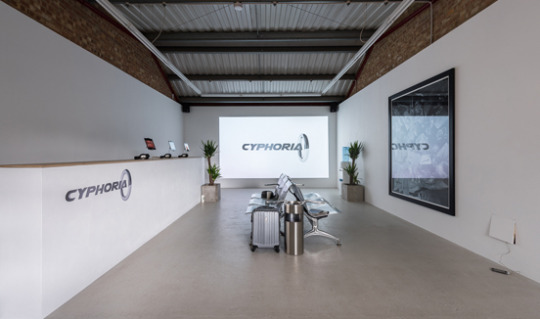
Stine Deja, ‘Cyphoria’, 2017. Installation View. Courtesy the artist and Annka Kultys.
Denmark-born and London-based artist, Stine Deja talks with Charlotte Barnard for Traction about her recent solo exhibition ‘Cyphoria’ at Annka Kultys, marking her first with the gallery.
Deja utilises an artful manipulation of video and digital media to create synthetic realities composed of highly polished and skilfully rendered architectural spaces and human avatars. These act as an interrogative tool, examining the ways in which the techno-sphere and digital technologies have altered human connectivity and understanding of self.
Through navigating the interstices between virtual and real worlds, in ‘Cyphoria’, the capitalisation of human emotion by the techno-bubble has been laid bare. In the staging of an immersive installation, physically resemblant of an airport departure lounge, Deja invited the audience to acknowledge their complicity in this contemporary extension and subversion of human existence. Encouraged to actively participate in becoming a ‘cyber traveller’; from the ‘irl’ physical acts of taking a seat, a drink of water, adding to the rubbish in the bin; to the virtual experience elicited through the visuals and voice-over, the viewer is forced to confront and be cognisant of the ways in which we transfer value and recognise ourselves through the screen of digital media.
'Cyphoria' at Annka Kulty's, is the first time I have come across your work. You use digitally rendered video to pose questions around the growing dependence of human connection on digital media. What interests you so much about this area of contemporary life?
In an age of digital dependency and mass migration to ‘virtual’ spaces, I find it super interesting to explore the overlaps and gaps, the malleable borders of the ‘real’ and the ‘virtual’. Digital technologies are now almost ubiquitous in every part of our lives and as they become more advanced and integrated they become more invisible.
In the Western context at least, we are continually occupying hybrid spaces, where people are simultaneously off and online, using objects that are technologically attached and detached. This has affected intimacy as people try to come together whilst maintaining their connection to everything else. I love observing and participating in this (contemporary) life.

Stine Deja, ‘Cyphoria’, 2017. Installation View. Courtesy the artist and Annka Kultys.
We are welcomed into a physical space resemblant of an airport departure lounge. The imagery in the video also references this and we are informed by the voice-over that we are going on a 'journey'. Could you discuss what interests you about this space as a platform for what is discussed in the work?
I chose the airport because I see it as a transient space with boundaries (and borders) that react to the person crossing them. I wanted to try and overlap this metaphor with the ways in which humans now ‘travel’ on and offline as part of their daily routine. The internet, when constantly accessible, offers infinite ‘destinations’ and each of those routes is unique as it is defined by the imagination of the person navigating it. I thought that the airport aesthetic was appropriate for this reason and it interests me because of it’s muted minimalism and futurist metallic accents that also are woven through the video. I thought that simulating the airport in the space as part of the installation would both mirror the environments in the video whilst also putting the audience in the apprehensive and adventurous frame of mind that airports sometimes put you in.
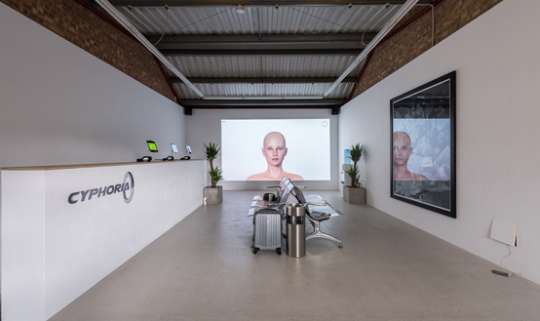
Stine Deja, ‘Cyphoria’, 2017. Installation View. Courtesy the artist and Annka Kultys.
I was struck by your complex overlapping and intertwining of motifs found in the comprising elements of the show; the video, voice-over, print and installation. It creates an extremely immersive and visceral experience for the viewer, where we are pushed to be 'active' participants. Was this the desired effect and, if so, why was it so important to you that the viewer be so implicated in the work?
I definitely wanted to create a space that allowed the participant to give themselves away to the thought experiment. We are so used to watching videos and pictures on our screens all the time, most of which we don't really digest or take in. We are experts in filtering relevant pixels, therefore I hoped that creating an airport lounge would optimise the relevance of the video and give the viewers a more full sensory experience. Upon arrival at the exhibition participants are actually preparing for a departure and are forced to do the familiar rituals of checking for a flight, waiting, absorbing the environment and other strangers in the space, take a drink, throw things away - perform your private waiting room rituals in the public space.

Stine Deja, ‘Cyphoria’, 2017. Installation View. Courtesy the artist and Annka Kultys.
The print in the show was created by 3D printing your personal items, which was then (if I'm correct?) photographed and digitally manipulated to form the final image. I found the lengthy process you undertook, taking 'irl' objects and transforming them into the digitised and flattened, yet still 3-D, end image fascinating. Could you discuss your motives for choosing this process?
The print was created by 3D scanning body parts and personal belongings, such as my toothbrush, underwear and also myself. After digitising those, I put everything into a composition in a 3D software and then it went to print.
The idea behind the print was to prepare myself to be uploaded into cyperspace, I wanted to see what the representation would look like. In the print the objects have shifted, they are suspended and hyper-real. I can easily call upon them when transitioning from the real world to the virtual world. By translating my everyday fixed existence into digital objects I have achieved a deeper nomadic quality, with which I can move. The print is also related to the exhibition as it could be taken as a metaphor of how one's luggage could look three dimensional but completely flat, like a screen.
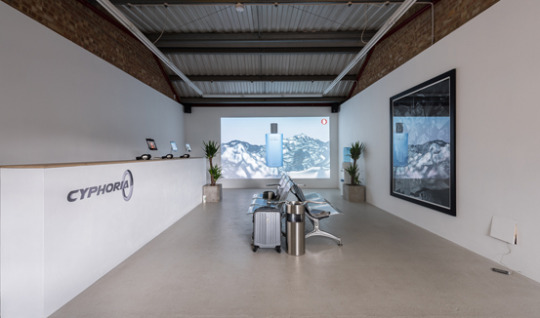
Stine Deja, ‘Cyphoria’, 2017. Installation View. Courtesy the artist and Annka Kultys.
Throughout the video piece, and within the installation, you engage water as a motif, here I refer to the Davidoff 'Cool Water' advert, the water-based animated text that is used within the video, the reference to 'floating' in the voice-over, as well as the water cooler that the viewer is invited to use. I'm interested as to why this element is of such prominence in the work? What interests you about the relationship between this natural element and the digital sphere?
To be honest, before you listed it out, I wasn’t really aware how prominent the water motif was, it happened somewhat unconsciously. I am certainly interested in reflections and playing with ideas of screens as mirrors or portals into environments beyond them. There is a clear narcissism in the ways in which we interact with glossy devices. Whilst a mirror displays back exactly what sits in front of it, a screen on the other hand can alter a persons identity both on and off line, perhaps more like a mirror illusion. In other works I have explored these ideas further and I think that water has become an extension of that.
Davidoff ‘Cool Water’ is a product that to me is inextricably linked to airports in the sense that it is always available in flight and in Duty Free shops. It was intended as a kind of timeless symbol of airport advertising, I just feel like it is something that you could find in any airport in the West for the last decade and the next decade to come.

Stine Deja, ‘Cyphoria’, 2017. Installation View. Courtesy the artist and Annka Kultys.
Carrying on from this question; through aligning the reference to bodies of water with your over-arching engagement in, as said in the press release, "...investigating the extent by which genuine emotional feeling within this virtual domain shapes us as social beings", I was drawn to inferring elements of hydro-feminist thought onto the work. This was reinforced by your choice to use a female avatar, 'Alena', as our guide. Is this an area of research that you are interested in?
I only recently discovered the work of Astrida Neimanis, so need to read more about hydro-feminism before I can answer that really. It certainly wasn’t a direct inspiration because I didn’t know about it at the time! But I am interested in gender and feminism so the choice of Alena wasn’t entirely unconscious.
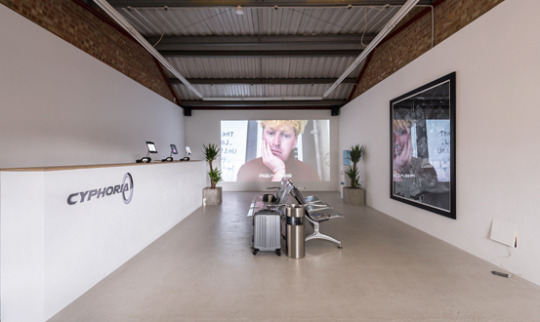
Stine Deja, ‘Cyphoria’, 2017. Installation View. Courtesy the artist and Annka Kultys.
There is much humour in the work, found as moments of parody and irony. Why do you use humour and what do you feel its value is as a tool?
Sometimes I feel like things become more apparent by highlighting a detail or a contrast, especially if it's something I find intriguing/weird/funny. Unlike computers we remember something best if we learn it in a context that we understand, or if it's emotionally important to us. For me humour is a way of emotionally engaging the viewer and its also a way of balancing a lot of information.That being said, I actually don't think too much about how I use humour in my work whilst making it, I guess it's more a natural flow of thoughts that luckily sometimes happens to be funny.
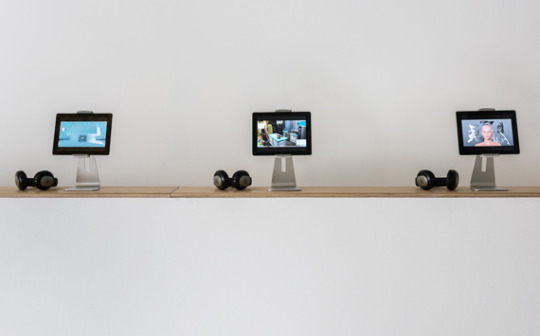
Stine Deja, ‘Cyphoria’, 2017. Installation View. Courtesy the artist and Annka Kultys.
Interview by Charlotte Barnard.
‘Cyphoria’ was on view at Annka Kultys Gallery from 22 March - 22 April, 2017. More at http://www.annkakultys.com.preview13.oxito.com/exhibitions/cyphoria/
To find out more about Stine Deja’s work follow http://stinedeja.com/
You can next view Deja’s work in ‘Synthetic Seduction’ (May, 2018), a solo show at SixtyEight Art Institute, Copenhagen. http://www.sixtyeight.dk/
#contemporary art#technosphere#virtual#real#illusion#reality#feminism#gender#digital art#video#techno-social#digital technologies
0 notes
Quote
Rather than thinking of 'Nothing' in negative terms such as ‘empty or ‘a lack of’, the artists we have brought together are interested in finding the ‘something’ in ‘nothingness’, in the same way that a poet considers the pauses in-between his words or a musician the silence in a piece of music.
Linda Hemmersbach
2 notes
·
View notes
Text
146. Fiona Grady, Linda Hemmersbach and Hannah Luxton
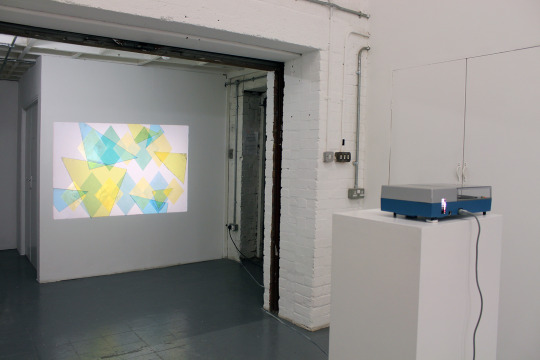
Fiona Grady, Spatial Shift, 2017. Slide projection on handmade egg tempera wall drawing.
A conversation between Fiona Grady, Linda Hemmersbach and Hannah Luxton about ‘Shaping the Void II’ an exhibition they have co-curated which brings together a group of artists whose work addresses ways to represent the concept of the void.
‘Shaping the Void II’ is currently at Tannery Arts, London, and includes work by Fiona Grady, Vincent Hawkins, Linda Hemmersbach, Robert Holyhead, Hannah Luxton, Isabel Moseley, Kate Owens and Lucy May Schofield.
‘Shaping the Void II’ follows on from a previous instalment - ‘Shaping the Void’ - at Bankley Gallery in Manchester. How are the two exhibitions linked?
LH: ‘Shaping the Void’ at Bankley Gallery in Manchester was a 3-person show which found a narrative between our individual practices; focusing on painting and site-specific drawing. After many conversations, emails and studio visits, we came up with the concept for ‘Shaping the Void’. The show focused on the idea of the Void within contemporary painting practice with regards to Spirituality and Eastern Philosophy, which perceives Nothingness as full of energy and light.
‘Shaping the Void II’ at Tannery Arts expands on this concept by including artists working in other mediums, such as sculpture and printmaking/light photography.
HL: Both exhibitions work to suggest that imagination is a vehicle to transport us in closer proximity to the void. For part 2, we wanted to open up the conversation to a more secular understanding of the void. The artists are concerned with absence, impermanence, intangibility, and the works operate within varying speeds of time.

Shaping the Void, 2017. Tannery Arts. Installation view.
FG: As Linda is based in Manchester and curates the space at Bankley Gallery, we wanted to offer an exchange by inviting her to use the project space at Tannery Arts (where Hannah and I have studios). This desire to promote exchange with other artists was important to us, so we invited Lucy May Schofield and Isabel Moseley to join us; who are based within the North West and North East of England.
How did the three of you develop this project together? How long has it been in the works?
LH: The conversations for ‘Shaping the Void II’ began pretty quickly after the show in Manchester in September. We had enjoyed working together and wanted to develop the ideas of the initial exhibition further. Fiona and Hannah had just started sharing a studio together at Tannery Arts next to the Drawing Room in Bermondsey, London. It has a Project Space which the studio holders can use for exhibitions, so it fell into place quite naturally.

Shaping the Void, 2017. Tannery Arts. Installation view.
FG: Tannery Arts encourages the studio holders to use the project space as an experimental venue, to challenge our practice, and to create opportunities for ourselves and other artists. For the second show we wanted to invite artists whose work we felt an affinity with; we mainly invited artists that we hadn’t met or worked with before. It was a great way to expand upon the earlier themes discussed during the development of the first exhibition. We aimed to introduce new entry points into the discussion of the ‘void’.
HL: For me, this project has been in the making for several years – I just didn’t know it until I met Fiona and Linda, and we realised we shared a connection with the subject. ‘Shaping the Void’ has allowed me to continue my MA research on the sublime in a visual format.

Shaping the Void, 2017. Tannery Arts. Installation view.
This exhibition brings together eight artists, each exploring the concept of the void. Where do these works, or bodies of work, overlap?
HL: All works in the show share a visual language rooted in abstraction and minimalism. They present a ‘hidden view’ that calls for intuition over logic, and operate in the realms of imagination where the usual boundaries of the physical world don’t exist.
LH: For example, Hannah Luxton’s linen paintings, Robert Holyhead’s watercolours and Fiona Grady’s wall drawings take the form of isolated geometric shapes, carefully composed and layered within the painted or projected space to allow for a heightened awareness of space and slower sense of time.
A particular attention to surface, colour and mark-making is also evident in my own and Vincent Hawkin’s paintings on panel and canvas. Shifts in tone and movement invite the viewer to study the paintings intimately, where paint has been applied and removed, leaving us to consider what has been built up, is barely there or on the verge of collapse.
FG: Kate Owen’s and Lucy May Schofield’s works share this sense of fragility but also opens up the concept of the Void to the element of time, presenting us with the afterimages of an event or action. Lucy May Schofield’s cyanotypes are mysterious but tangible objects of something seemingly intangible; the absence of light during Winter Solstice. Kate Owens’s paint-covered soaps are miniature worlds but they hold within them the process of something vanishing: did they assist the artist in removing a mural, or the traces of a painting process? Isabel Moseley is also fascinated with working with the intangible, both as a material and concept. Her delicate ‘window’ sculptures trap a volume of air creating an invisible space made visible for us to look through or into.
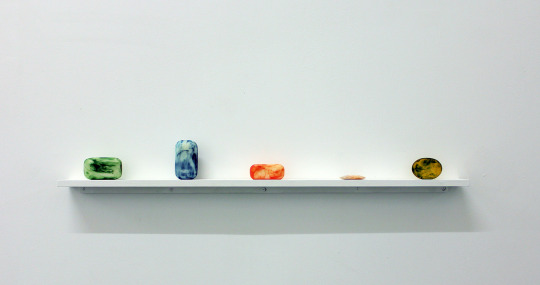
Kate Owens, Towards Zero (19-23), 2013. Soap and paint. Image courtesy Kate Owens and Limoncello Gallery.
These works all present physical responses to the concept of nothingness or absence. What do you think draws us to make something to explore the idea of nothing?
HL: The void, aka nothingness, is essentially the beyond of knowledge and is most readily assigned to notions of infinity or eternity. C18th philosopher Edmund Burke quotes that “it is our ignorance of things that causes all our admiration, and chiefly excites our passions. Knowledge and acquaintance make the most striking causes affect but little … the ideas of eternity, and infinity, are among the most affecting we have, and yet there is perhaps nothing of which we really understand so little …” It is the not knowing that will forever intrigue human kind.
LH: I think the notion of ‘nothingness’ creates a counterpart to the bombardment of images and information and crowded spaces of our contemporary world, which can be very hard to escape in day-to-day life. Perhaps the desire to make work that is not defined by language or descriptive, recognisable forms comes from a yearning for space, ambiguity, escapism and new possibilities.
Stripping something back to its essence and using minimal means to create meaning allows us to step out of the accelerated world in order to appreciate silence and slowness, to let the mind wander and invite mystery in. In a sense, ‘Nothingness’ doesn’t really exist and is a concept that is hard to comprehend for the human mind. Science is built on theories of Nothingness. Rather than thinking of ‘Nothing’ in negative terms such as ‘empty or ‘a lack of’, the artists we have brought together are interested in finding the ‘something’ in ‘nothingness’, in the same way that a poet considers the pauses in-between his words or a musician the silence in a piece of music.

Left to Right: Hannah Luxton, Untitled, 2017. Oil on linen; Hannah Luxton, Constellation, 2016/17. Oil on linen.
What is coming up next? Do you have plans for a third instalment of the exhibition?
LH: At the moment we are looking forward to our closing party on the 31st March, for which we are launching a publication about the project, to this date, with texts by art writers Sara Jaspan and Kathryn Lloyd. A third instalment of the exhibition would be wonderful as there are still many artists we would love to work with.
FG: Yes, a third instalment would be great. We’ve been really pleased with the response that we’ve had for the project so far so it would be worth pursuing for 2018, perhaps in a larger space, or new context. Each of us is also working on other projects such as curation Footfall Art (Hannah), Bankley Gallery (Linda) and contributing to Saturation Point (Fiona); as well as working in our individual studio practices towards solo shows and residencies later in the year. I have my first solo exhibition abroad at Ad Hoc in Bochum, Germany this summer which is pretty exciting.
HL: It looks like we are all agreed on part three for the future. And yes, Footfall Art, my pop up window project, hopes to ‘pop up’ again this summer! I have a solo exhibition in Farnham Maltings this May and some other group exhibitions to look forward to.
Interview by Susie Pentelow.
‘Shaping the Void’ continues until 31 March at Tannery Arts, London SE1 5SF, with a closing party on Friday 31 March, 6.30 - 8.30pm. For more information, visit http://www.shapingthevoid.co.uk.
For more on Fiona Grady’s work, visit http://www.fionagrady.co.uk. For more on Linda Hemmersbach’s work, visit http://www.lindahemmersbach.co.uk. For more on Hannah Luxton’s work, visit. http://www.hannahluxton.com.
#Fiona Grady#Linda Hemmersbach#Hannah Luxton#Shaping the Void#Tannery Arts#London#interview#artistinterview#curatorinterview#artist#curator#art#contemporary art#Vincent Hawkins#Robert Holyhead#Isabel Moseley#Kate Owens#Lucy May Schofield#Saturation Point#Footfall Art#Bankley Gallery#exhibitions
0 notes
Text
145. Marion Coutts
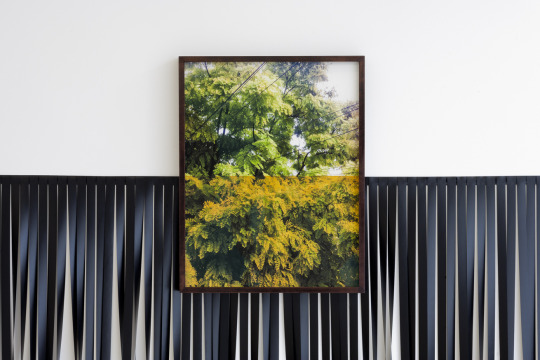
Marion Coutts, False Acacia Aurea (installation view), 2017. Iodine on digital print; 50 x 39 cm. Edition of 10 + 2 AP. Photograph: Cameron Leadbetter.
Marion Coutts talks to Traction about her current solo exhibition at Tintype, London. An artist and writer, Coutts published her memoir, ‘The Iceberg’ in 2014. For ‘Aiming or Hitting’, Coutts presents an installation combining sculpture, photographs, text and - for the first time - drawings.
The wall-based works in ‘Aiming or Hitting’ are presented in relation to a set of black strip-curtains running the length of the gallery. What is the relationship between these two elements?
The black strips make a space for images to operate against: above, below, in front, behind. I want to test out further what the curtain can do. I imagine doing a show where the curtain is installed as the only element.
You are a writer and artist. How do these two roles play out in your practice?
I’m not sure yet. My book – ‘The Iceberg’ – came out in 2014. It was written during a period when I was not making any artworks. Now I have made some artworks and am finding it hard to write anything. The two seem mutually exclusive at the moment. I expect that won’t last forever.
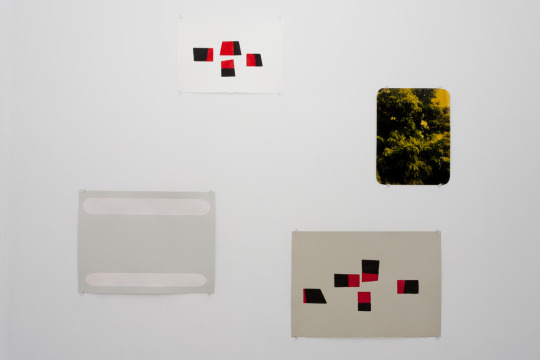
Marion Coutts, Installation view – works on paper, 2017. Photograph: Cameron Leadbetter.
This is the first time you have shown your drawings. How do these works relate back to the body of photography?
Photography is new to me so I am working it out. I think of them as images more than photographs, though they are generated photographically in various ways. I always saw drawing as part of a thinking process, rather than an end in itself, but because I was having to think about paper as material in making digital prints – taking up ink in radically different ways - I started to think more about paper generally and what I might draw on. So rather than using what was lying about the studio – generally junk - this led to trying new papers and new material to draw with and that grew into more drawings. The drawings are only a small part of the show but I quite like them there.

Marion Coutts, Aiming or Hitting, 2017. Installation view. Photograph: Cameron Leadbetter.
Is there a particular artist or writer who has been influential in your work?
In this show particularly, I was thinking of the work of Felix Gonzalez-Torres. I worked on the Gonzalez-Torres show at the Serpentine in 2000, which was his first major exhibition in the UK and I have strong memories of it. The work was formal, sculptural and intimate. I’m interested in what happens in the encounter with an artwork that moves you and I made some work based on one of his posters. In the show there is also a work called ‘Boy Looks at Rock on Top of Another Rock’, an image of a boy looking at a sculpture by Fischli and Weiss.
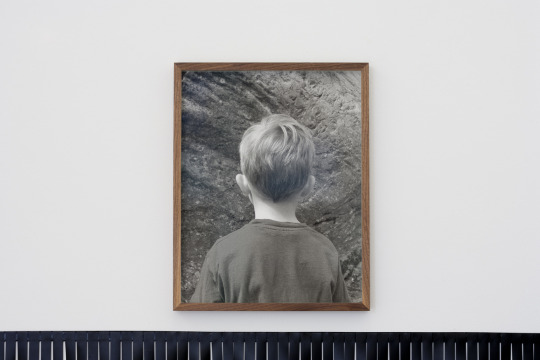
Marion Coutts, Boy Looks At Rock on Top of Another Rock (installation view), 2017. Archival pigment print; 44 x 34.5 cm. Edition of 10 + 1 AP. Photograph: Cameron Leadbetter.
What is coming up next for you?
I am working on more images. I am going to learn more about cameras. I am going to do more writing.
Interview by Susie Pentelow.
Marion Coutts’ solo exhibition ’Aiming or Hitting’ continues at Tintype, London, N1 2SL until 13 April 2017. For more information, visit http://www.tintypegallery.com.
For more on Marion Coutts’ work, visit http://www.marioncoutts.com.
#Marion Coutts#exhibitions#London#Tintype#Aiming or Hitting#artist#art#contemporaryart#interview#Photography#drawing#Felix Gonzalez-Torres#writing#writer#Fischli and Weiss
1 note
·
View note
Quote
I’m interested in what happens in the encounter with an artwork that moves you.
Marion Coutts
0 notes
Quote
I embrace an elasticity of sculptural technique that harnesses the values, principles and commitments of a sensibility preoccupied with the phenomenological experience of materiality and space but doesn’t always look like the classic notion of sculpture.
Lucy Tomlins
0 notes
Text
144. Lucy Tomlins

Lucy Tomlins, Saturday Worship, 2013. 11 minute multi-channel audio loop, The Chapter House, Worcester Cathedral. Photograph: Dominic Tschudin. Image courtesy the artist.
Lucy Tomlins talks to Traction about her upcoming public sculpture commission, ‘Pylon and Pier’.
Playing with traditional notions of public sculpture as a means with which to reinforce the status and prestige of those in power, Tomlin’s sculpture, sited in London’s Bermondsey Square, will show the Titan Atlas – not, as in Greek mythology, condemned to hold up the sky for eternity, but rather toppled from his plinth, as if the weight of the globe he clutches has overwhelmed him.
‘Pylon and Pier’ will be the first of three commissions that will form the second phase of ‘SCULPTURE AT Bermondsey Square’. Prior to its launch next week, Tomlins unpacks some of the ideas behind the piece in a conversation with Susie Pentelow.
Your new work ‘Pylon and Pier’ takes inspiration from Wallace Stevens’ poem, ‘The Public Square’ (1931). How did this poem influence you?
The poem is from Wallace Steven’s first book of poetry ‘Harmonium’ (1931) and describes the falling of a building in a public square.
‘A slash and the edifice fell,
Pylon and pier fell down.
A mountain-blue cloud arose
Like a thing in which they fell’, he writes.
At the time of modern industrialisation and the Great Depression, the edifice’s demolition is used as a symbol of the loss of a tradition or idea; the collapse of a system. There are a lot of parallels being drawn with today’s socio-political context and that of the 1930s and reading the poem, it could have been written today. It resonated with me and became the jumping off point for the work. The poem also uses a modernist, architectural structure which relates to the visual language of my own work and directly informed the minimal clean form of the plinth. The title is also a direct citation. Pylon makes reference to the Greek origin of the word pulōn meaning gate, a point of transition, and pier another place of departure.

Lucy Tomlins, Concrete Country in White, 2011. Cast concrete; 2.5 x 2.05 x 1.8 m. Photograph: Antony Mottershead. Image courtesy the artist.
I particularly enjoy making work that is site responsive, where the sculpture is what it is just as much because of the dialogue it has with its immediate, situated context as to what form it takes or what it is made from; how it is read in relation to the world around it. When I was invited by VITRINE to make work for Bermondsey Square, I took this opportunity to directly consider the nature and function of the public square, as a space for coming together, a meeting place, for ideas exchange. Squares have long and lively histories, of rallies and public voice, a place for democracy as well as with more violent histories. The poem locked in some of this thinking.
The fallen figure of Atlas in your sculpture reminds me of the symbolic gesture of toppling a statue, something that we often see (via the media) as an act of protest or rebellion. Does this link to your work?
Absolutely. Traditionally, the public square is where statues of distinguished people are sited, usually placed there to reinforce notions of power or national prestige. Their toppling has become the visual symbol of the overthrowing of a system, in the same way as Stevens used the collapse of the building.
The figure represented in my sculpture is the Titan Atlas, as a young man. Not as in Greek mythology holding up the sky for eternity, but collapsed under the weight of the world and its problems. Though not didactic, my work has often involved social commentary and it feels difficult, at this specific time, not to make work that is in some way responsive to the socio-political context we find ourselves in post-Brexit and Trump. ISIS also uses the media to spread imagery of the vandalism and destruction of ancient artefacts in their attempt to erase history and our connection with the past and traditions. The fallen statue is a very loaded image, full of history but also of the moment.

Lucy Tomlins, CGI Rendering for ‘Pylon and Pier’, 2017. Image courtesy the artist.
‘SCULPTURE AT Bermondsey Square’ feels particularly exciting as a public sculpture programme because the sculpture is installed for six months, rather than permanently, freeing the commissioned artist from the constraints of making something permanent. Has this factored into your plans for the work?
Because the work is only on display for six months it has meant I’ve been able to make a work which specifically factors in time as a key element in its conceptual meaning. Something so time-specific, as well as context-specific, is a rare opportunity. If I’d been invited to contribute to the first phase of Sculpture At (2014/16) this work could not have been made.
Practically, a temporary installation means you can do more with a small budget as there is less expense around durability of materials, health and safety, installation and planning constraints etc. The work can be more experimental as with something permanent there are a lot more stakeholders you have to get agreement from which can often mean the dilution of an idea or a ‘safe’ work gets chosen. Look at all the great temporary works that have been on the 4th plinth from Wallinger’s ‘Ecce Homo’ (1999-2000) to Katrina Fritsch’s ‘Hahn/Cock’ (2013-2015). Would those works have been allowed if they were permanent? I don’t think so.
I was also able to use this opportunity to experiment with digitally design and production techniques (5-axis milling and 3D printing) for the first time. This is an expansion of my usual practice which is much more hands on and so a new area for me. Knowing that the work is only on display for six months, I felt I could experiment in a way I may not have felt comfortable with if the work had been permanent.
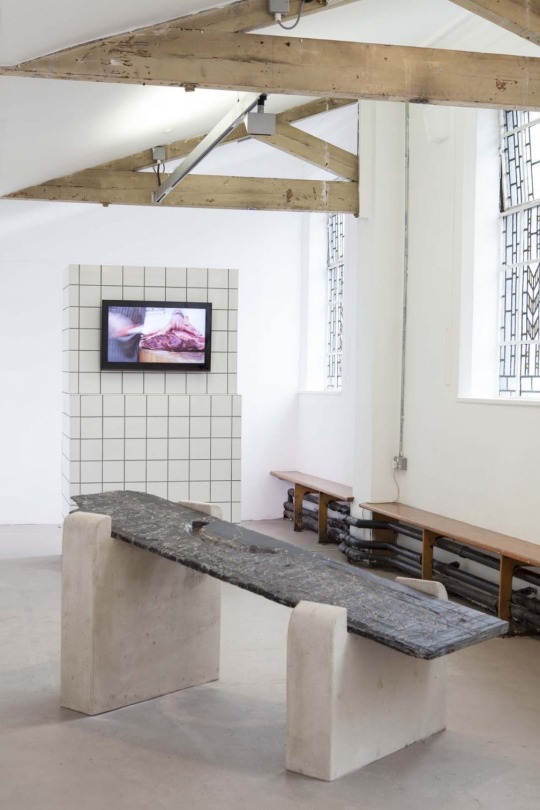
Lucy Tomlins, Accidental Artwork, 2013. Slate, concrete. Photograph: Tim Bowditch. Image courtesy Zabludowicz Collection.
You emphasise your role as a sculptor, something that is becoming increasingly rare as more and more artists discard medium-specific labels. Why is this so important to you?
There are a lot of cross-discipline artists today but I think often this can also mean that an artist has only skimmed the surface of these disciplines rather than gaining a deep-rooted knowledge or skill in any of these art forms. My work also engages in non-traditional sculptural techniques, such as video and sound, but I work from an area of specialisation and engage outwards into these disciplines from within a sculptural sensibility. I think taking a position like this and making it public also helps the audience to know how to approach and engage with the work, as it gives a sense of the artist’s intent.
Ossian Ward [in the panel discussion ‘True or False: There’s no such thing as Sculpture’; (July 2013, Pangaea Sculptors’ Centre)] talks about a sculptural sensibility as a ‘frisson’ between man and ‘something’, a literacy of sorts and a sense or sensuous knowledge. To say I am a sculptor defines how I approach my art practice and how my artworks should resonate and be read. I am committed to the importance of craft skills as a principle but this is not a traditional notion of sculpture. I embrace an elasticity of sculptural technique that harnesses the values, principles and commitments of a sensibility preoccupied with the phenomenological experience of materiality and space but doesn’t always look like the classic notion of sculpture. Though ironically, on this occasion, in ‘Pylon and Pier’, I have intentionally chosen to create a pastiche of a classical statue. In a time of dematerialised art practice, where there is so much ‘stuff’ that seems to be intentionally unintentional, to work from a clear position such as this might almost be avant-garde or radical.
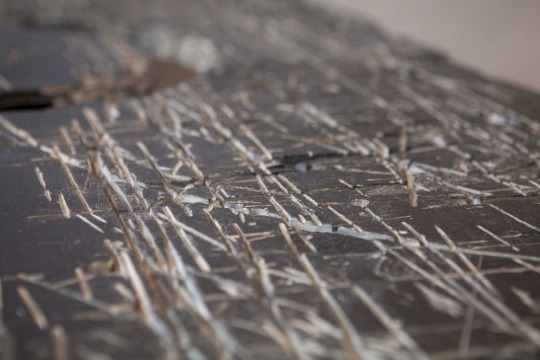
Lucy Tomlins, Accidental Artwork (detail), 2013. Slate, concrete. Photograph: Tim Bowditch. Image courtesy Zabludowicz Collection.
This is the first in a new body of works you will be developing. What are your plans for these?
Last year, I moved from London to live and work between London and Castéllon, in rural Spain. Moving my studio practice to the dramatic environs of the Spanish mountains has enabled space for reflection, a renewed vigour for my studio practice and has resulted in a new body of work that for the first time directly references a range of historical artworks, across various art forms, from poetry, to film, to classical sculpture. I’ve been looking for, and taking inspiration from, historic works that, through a ‘remaking’, seem just as relevant now as at the time they were made. This includes the ‘Farnese Atlas’ (at the Museo Archeologico Nazionale, Naples) for Pylon and Pier. The next piece getting a remaking is Michelangelo’s ‘The Dying Slave’, which is being reimagined for the 21st Century, eroticised as a figure that holds within it both the male and female form. This will be shown later this year in Mexico.
Interview by Susie Pentelow.
‘Lucy Tomlins: Pylon and Pier’ launches on 30 March 2017 and will stay in situ until 24 September 2017. The sculpture will be sited on Bermondsey Square, SE1 3UN. For more information, visit http://www.vitrinegallery.com/collections/sculpture-at/
To find out more about Lucy Tomlins’ work, visit http://www.lucytomlins.co.uk.
#Lucy Tomlins#Sculpture at Bermondsey Square#Atlas#mythology#public sculpture#Pylon and Pier#Pangaea Sculptors’ Centre#Wallace Steven#Ossian Ward#Michelangelo#sculpture#materiality#art#artist#contemporary art
0 notes
Text
143. Sherman Sam
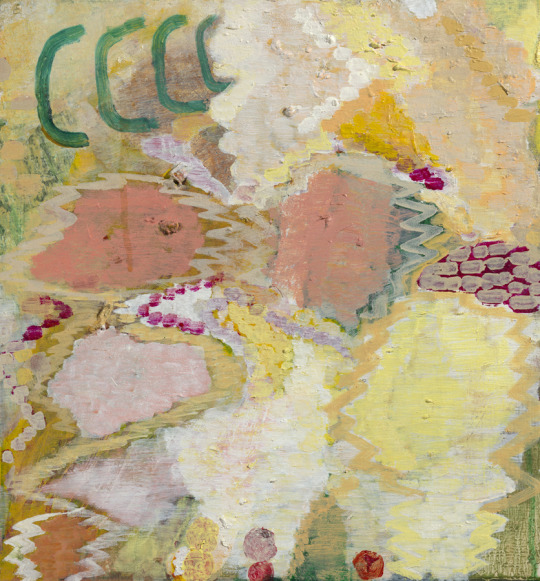
Sherman Sam, Do The Same Again, 2016. Oil paint on ply; 31.4 x 29.1 cm. Image courtesy the artist and Annka Kultys.
Following his first UK solo-show at Annka Kultys, London, Traction talked with abstractionist painter, Sherman Sam, about his process and approach to painting. Focusing on the transience and movement of colour, surface, light and intuition; whilst his painterly style can be aligned with the East-Coast Abstractionists, his work opposes typically Western notions of narrative structure altogether. With a career that has spanned the last three decades and across three continents, Sam is a vastly knowledgeable, engaged and enquiring mind in the field of Contemporary Art. A pre-eminent art writer, Sam contributes regularly to Artforum International.
Could you discuss how you approach each painting? Do you have any rituals or particular processes which determine how the work begins and then evolves?
I wish I could say that it’s like being a sportsman where you have your lucky boots, or cross yourself then kiss the field before you play… but it’s not quite like that. Not even lucky brushes or painting slippers… dammit!
At any one time there are some 15-20 works in progress. Some of these have just been sitting in the studio for some years. I would say that half of them are getting more attention than the rest. I move them round, glance at them. A touch of paint here and a touch there, that’s the main action, and not always every day. BUT it is the looking and trying to stumble on to a solution or way forward that takes the time. Well, sometimes it’s not a stumble, but the accidental path is always the most satisfying because it’s so much less predictable. So even those seemingly forlorn pieces sitting around collecting dust, are really still being thought over somewhere in the back of my mind.
How does a painting come together? First I cut and assemble the panels. So when I begin to paint, they already have some sort of determined rectilinear shape. Then I make some marks on the primed panel, maybe a splatter or two, or in earlier pieces a light wash. These actions determine some of the under structures of what becomes the painting. Likewise my drawings follow a similar process. They come about in a process of, lets call it, searching, working through, erasure and then finally equipoise. They too are cut from larger sheets of paper. Both drawings and paintings are the result of some kind of spontaneity and predetermination.

Sherman Sam, Installation view ‘Together We’re Heavy’, Annka Kultys Gallery, London, 17 November- 17 December 2016. Image courtesy the artist and Annka Kultys.
How has your formal language evolved with time?
Let’s call them the things I paint and draw.... “Formal language” begs for “conceptual ideas” and I don’t believe the two are separate. I think the two are so integral to each other in the best work that one cannot speak of one without the other. When I began to conceive this work in the mid-90s, I think the forms in the paintings were very organic and biological on the one hand, and architectonic on the other. You could say that American East Coast abstractionists emerging in the 80s like Tom Nozkowski, Jake Berthot, Gary Stephan, Jonathan Lasker, offered a point of departure. The forms then were usually painted on a rough field or background. The paint itself was quite thick. I think over the years, form and ground have become more intermixed while the paint has become thinner though still layered. The nature of the forms themselves, more and more, are now more constructed through gestures. So dabs of paint come together to define or outline form.
But it is not just the visual language that has evolved; there is also the thing language. The paintings (as opposed to pictures) began as more precisely made things, nicely into having a slightly more wonky (just a bit) handmade nature. Why? Paintings are things in the world, like, well, other things in the world. However they might just sit there and be a bit more thoughtful. Their imprecise nature is a reflection of their internal logic but also the rickety world around us.
Looking at the work in your show at Annka Kultys, I found myself finding references to pattern and western language. How do you feel when these figurative readings are transposed onto the work? How would you choose to describe these forms?
When asked I describe myself as an abstractionist. But if I were a pedant, I would say they really are non-representational. Basically there is no referent, no narrative; sometimes I don’t even think there is any theory. But I like that viewers see things, and find things in them. Isn’t that your job as a viewer? To see and think. Interpret. To make meaning. So I am pleased that you see what you see.
I do like patterns, you should have visited my knitwear collection instead, but in the art it is more about repetition rather than a contentious creation of design. If you see patterning, it is really more the movement of the hand or arm, again and again. Don’t they say that as human beings we look for patterns? As for language, do you mean western language? As opposed to Eastern language?

Sherman Sam, Just a Perfect Day, 2014. Oil paint on ply; 54.4 x 40.1 cm. Image courtesy the artist and Annka Kultys.
Yes, I found myself seeing references to the Latin or Germanic alphabet, which I know is based in my anglicised reading of certain forms.
I think in the drawings there are more graphic elements that could be construed as being derived from architectural diagrams and also graphics but less so in the paintings. But I think the element that most resembles what you are talking about can be found in do the same again, 2016, where there are four green curving marks suggesting “C C C C” the first being the largest and descending in size to the four, that is if you look from left to right. I think of it as marks emanating from right to left, like a force growing or in today’s terms, that little Wi-Fi strength signal on your phone or computer. And no, it is not derived from computer graphics, more like, in my mind at least, movement lines that you find in comic books. American comics when I was a kid inspired me to draw, you can blame them for my art. It is really mark making and repetition. Well, as I said what you see is what you see, or is that what you think you see is what you think?
You have lived in diverse geographical regions, hailing from Singapore you moved to Paris, the US and then London. What impact have these migrations had upon your practice?
Lots! Though I think unquantifiable. First you are exposed to different approaches to art making, not to mention different scenes, people, times, thinking and cultures. Now we have better, more instant information, so in a way we are better informed. Back then you just had to go somewhere; otherwise magazines and word of mouth were the only other sources. If you grow up in a small country like Singapore, where there was hardly any visual art when I was young, you really had to travel. Then there wasn’t even a museum dedicated to art. Today I still think you still have to physically see and experience art. Sure its images are transported and transposed, but the experience of a work is still key. On the other hand this does explain why so much art is made of images and about image.

Sherman Sam, Installation view ‘Together We’re Heavy’, Annka Kultys Gallery, London, 17 November- 17 December 2016. Image courtesy the artist and Annka Kultys.
As an artist I like to think I have a bit of Paris, Los Angeles and San Francisco in me, not to mention a whole lot that is Singaporean. However it is French and New York painting that are probably the most influential to the aesthetic journey I have taken. I would the scale is more European but the language and ideas begin on the East Coast. As for the Asian and Chinese bits, well I think its somewhere in there too, submerged but present.
Interview by Charlotte Barnard.
Sherman Sam’s exhibition, ‘Together We’re Heavy’, was on view at Annka Kultys Gallery, London 17 November – 17 December 2016. Read more here.
Sherman Sam is nominated for the 2017 Sovereign Asian Art Prize in Hong Kong – Asia’s most esteemed contemporary art prize.
He is soon to have a solo exhibition opening in Paris, to keep up with this, and other news regarding his work, please follow his artist page here.
#artist#sherman sam#painting#abstract#writer#annka kultys#london#Paris#east coast#image#Form#graphic#Architecture#diagrams#east coast abstractionists#process#exhibitions#artist interview#pattern#movement#language
3 notes
·
View notes
Quote
Paintings are things in the world, like, well, other things in the world. However they might just sit there and be a bit more thoughtful. Their imprecise nature is a reflection of their internal logic but also the rickety world around us.
Sherman Sam
#artist#artist quote#painting#abstraction#colour#light#surface#language#objects#reflection#architectonic#sherman sam#oil painting#form#concept#negotiation
0 notes
Quote
My concern then is not why otaku do what they do, but rather, what kind of space allows this to happen? It is as if the extremely dense accumulation of cramped interior spaces that characterise so many cities today encourages a turning inward, or a vacuum of mental space itself.
Nadim Abbas
0 notes
Text
142. Nadim Abbas
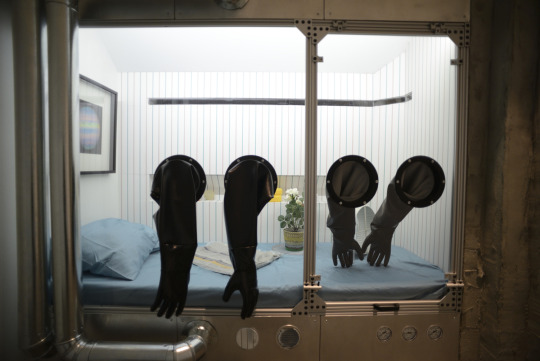
Nadim Abbas, Chamber 664 "Kubrick��, 2014-2015. Mixed media. Dimensions variable. Image courtesy of the artist.
Susie Pentelow interviews Hong-Kong based artist Nadim Abbas about his upcoming solo exhibition ‘Camoufleur’ at VITRINE, London. For ‘Camoufleur’, Abbas will produce a new, site-specific installation which will use camouflage to explore how urban living conditions can dictate our relationship with, and in some cases submission to, the spaces we inhabit. The installation will be accompanied by a series of scheduled performances in the space.
You currently have a solo show at Antenna Space in Shanghai, ‘Chimera’. Could you talk a little about this work?
The starting point was the image of the human rhinovirus (serotype 14), AKA the common cold, which I constructed using various kinds of open source molecular and 3D modelling software. The title connotes both phantasmal and biological origins. The elaborate way that I have chosen to present, or project these viral images into the gallery space, using air blowers and beach balls is an attempt to maintain the ambiguous quality of an image which wavers between real and imaginary, fact and fabrication.

Nadim Abbas, Human Rhinovirus 14, 2016. Mixed media installation. Dimensions variable. Image courtesy of the artist and Antenna Space.
The choice of the common cold virus was deliberate - as something familiar to all, to the point of banality, yet appearing at the same time completely alien. Everything else in the show is an extension of this viral metaphor. This is most blatantly played out in the two isolation chambers (with echoes of my piece at the 2015 New Museum Triennial), which contain a series of modular geometric forms that act as a playground for renegade toilet rolls.
The work ‘Blancmange, n ways’ acts as a separate counterpart with similar thematics. Here, white forms become specific manifestations of the first four iterations of the fractal Blancmange function, which derives its name from its resemblance to the famous dessert. In England of course, ‘blancmange’ also connotes a boring or uninteresting person. The photograph on the wall depicts an actual blancmange pudding, as does the pattern design on the wallpaper - setting up a visual pun of sorts.
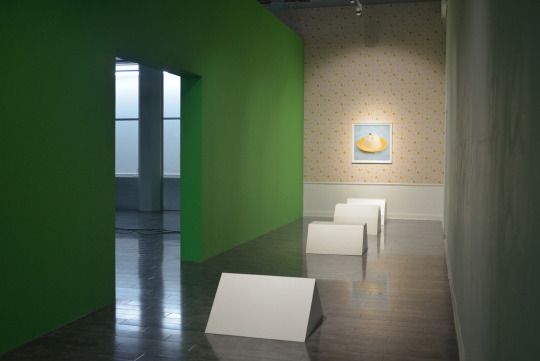
Nadim Abbas, Blancmange, n ways, 2016. Mixed media installation. Dimensions variable. Image courtesy of the artist and Antenna Space.
Works like ‘Chamber 667’ and ‘Chamber 664 "Kubrick”’ could almost be sets from a science fiction film. Is sci-fi an influence?
Regarding the sci-fi influence - the short answer is yes! I am a big science fiction nut. I wrote a short text on this connection (between sci-fi and my work) many years ago. It was around that time that I discovered these molecular renderings of viruses, which were later to become the central motif of 'Chimera'. The text was never published, and I'm not even sure that it makes any sense. Basically, 'Chimera' was my way of materially resolving some of the concerns that were started in writing.
There are many visual parallels between my work and cinema, simply because much of what I do involves the notion of converting (lived) space into an image (memory), which is something that comes almost second nature to the cinematic process. Given the popularity of sci-fi blockbusters today, I should clarify here that I'm less interested in constructing seamless, illusory images like you might see in the latest Star Wars spin-off. Rather, I'm fascinated with finding ways of letting the inconsistencies show through, like in a low budget B-movie. In other words, there is always an element of theatre present in my approach.

Nadim Abbas, The Last Vehicle, 2016. Mixed media installation with durational performance. Dimensions variable. Image courtesy of the artist .
You are working with camouflage for this installation/body of work. How do you think this idea reflects broader themes in society?
A lot of my recent work tries to unravel how certain conditions of urban domesticity have produced specific types of sociability and subcultures. I am also fascinated by what at first glance seems like an unlikely correlation between domesticity and warfare; how technologies developed on the battlefield have found applications in quotidian contexts and vice versa. More chilling perhaps is the notion, suggested by theorists such as Paul Virilio and Beatrice Colomina, that the dream of domestic bliss is but a dormant extension of an ongoing militarised state of emergency, where the household finds its mirror in the bunker/fortress.
It is no coincidence, for instance, that iRobot, a manufacturer of automatic vacuum cleaners, displays on its website products dedicated for the “home” side-by-side with similar technologies repurposed for “defence and security”. Taglines such as “Welcome home. Your house is clean” are made in the same breath as “Placing a safer distance between people and danger”. Since the machinations of modern warfare destroy the very condition of human habitats, military constructions have become increasingly geared towards the possibility of inhabiting such artificial climates (e.g. the underground bunker as a refuge from nuclear fallout). The modern household simply adapts this formula by providing increasingly artificial climates optimised for human habitation (e.g. the fully automated, air-conditioned high-rise service apartment).
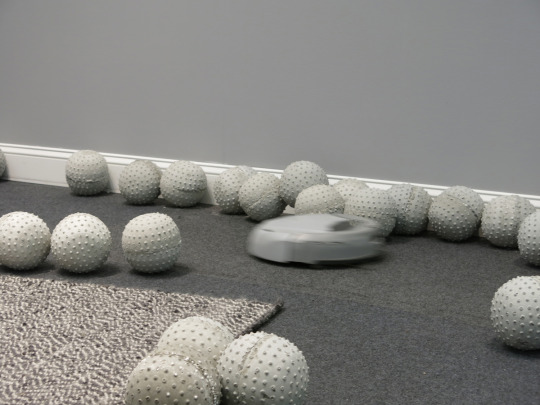
Nadim Abbas, Zone I, 2014. Lightweight concrete casts, robotic vacuum cleaner, rug, skirting board, house paint. Dimensions variable. Image courtesy of the artist.
The title “camoufleur” is borrowed from the name that was given to people who designed and implemented military camouflage during WWI/WWII. Many of these camoufleurs were artists but there were also zoologists and naturalists such as Hugh Cott, whose book, Adaptive Coloration in Animals became a seminal text for the study and development of camouflage techniques in the military. For the setup at VITRINE, I will design a wallpaper pattern that becomes the backdrop and point of reference for everything that is subsequently placed in the space.
For this body of work, your focus is on the figure of the “otaku” or “hikikomori”, terms which originated in Japan. Can you explain these?
Otaku and hikikomori are (Japanese) terms that have come to represent stereotypes of socially ill-equipped, middle-aged males who wall themselves up at home in an escapist world of manga and anime consumption. Otaku generally refers to participants of a subset of cultural practices that revolve around manga and anime fandom. Hikikomori refers to the specific phenomenon of acute social withdrawal. In Chinese, otaku is often translated as “jaaknam” or “zhainan”, which literally means “resident male” (as in resident of a housing complex or tenement block), thus conflating the connotations of otaku and hikikomori. It would take a lot more explanation to unpack the respective nuances of these terms and their ongoing mutations, so I will just focus on the fact that otaku culture arose, or at least thrives, within a uniquely urban, post-industrial context.
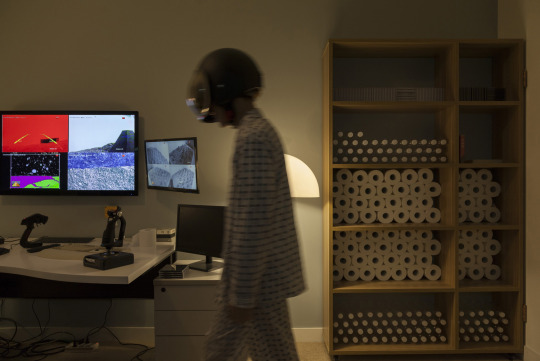
Nadim Abbas, The Last Vehicle, 2016. Mixed media installation with durational performance. Dimensions variable. Image courtesy of the artist.
My concern then is not why otaku do what they do, but rather, what kind of space allows this to happen? It is as if the extremely dense accumulation of cramped interior spaces that characterise so many cities today encourages a turning inward, or a vacuum of mental space itself; a vacuum that disturbs the distinction between the animate and the inanimate, or subject and object. This logic is made visible in the practice of mimicry: picture a masked body, driven to disappear into its surroundings, to be engulfed by objects whose animation increases in proportion to its own lack of animation.
How will you respond to the position of the space on the public sphere?
The unique positioning of the VITRINE space, which stays open and visible at all hours of the day, creates an interesting set of possibilities for the public display of domesticity. The window display, which can more easily facilitate instances of repeated daily viewing, structures an encounter that varies according to the state of each visit. It is this durational quality that pushed me to find different ways of inhabiting the space at different points of the day/week/month. States of habitation that when considered together start to overlap, and become harder to distinguish from one other: a performer who behaves like a machine, or a machine that is performing?

Nadim Abbas, #4, 2016. Cosplay helmet mounted on green screen / cyclorama. Dimensions variable. Image courtesy of the artist and Luke Casey.
There will also be a performance aspect to the exhibition - can you talk about your ideas for this?
The performer will be presented with a set of instructions, or perhaps a distilled script of some sort. We will work together in advance to develop a specific body language. I’m looking for someone with the type of movement training that would facilitate the emptying of gestures, or gestures that do not call attention to themselves, the gesture of stones. If the objective is to perform a disappearing act, it would seem that the magician has already disappeared before the act has begun. Likely candidates might include people who are trained in physical theatre, mime, Butoh; or even life models, who like stick insects are inclined to assume the same pose for extended periods of time.
Interview by Susie Pentelow.
‘Camoufleur’ will run between 1 March and 15 April 2017 at VITRINE, London SE1 3UN, with a preview on Tuesday 28 February 2017, 6.30 – 9 pm. For more information, visit http://www.vitrinegallery.com/exhibitions/camoufleur/.
‘Chimera’ continues until 22 January 2017 at Antenna Space, Shanghai. Visit http://www.antenna-space.com/en/exhibitions/chimera for more information.
Find out more about Nadim Abbas’ work at http://www.nadimabbas.com.
#Nadim Abbas#Chimera#Camoufleur#exhibitions#London#Shanghai#performance#installation#iRobot#technology#Otaku#Hikikomori#cosplay#urban#post-industrial#art#artist#artist interview#traction#subcultures#sci-fi#VITRINE#Antenna Space
1 note
·
View note
Text
141. Elly Thomas
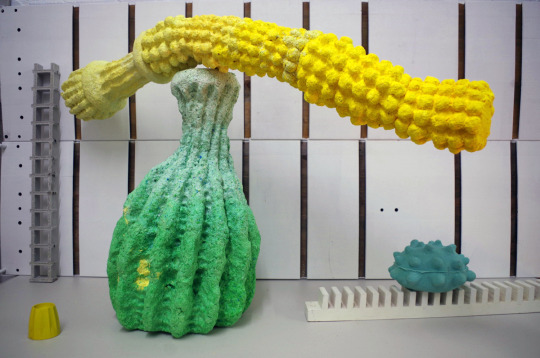
Elly Thomas, ‘Czar’, 2017. Papier-mâché, silicone and found objects. Image courtesy of the artist.
Elly Thomas is an emerging artist who uses sculptural forms to navigate how childhood play can inform adult creative processes. Creating a series of forms, which are then combined into various improvised assemblages, Thomas uses these impermanent structures to explore animism and autonomy of objects. Having completed a PhD in 2013 at Slade School of Fine Art, UCL, where her thesis was titled ‘Play as Evolving Process in the Work of Eduardo Paolozzi, Philip Guston and Tony Oursler’, Elly is now a leading mind on Paolozzi and Guston’s practices and will soon be releasing a book with Routledge discussing their processes and output. Here, Thomas talks with Charlotte Barnard for Traction.
You create sculpture and drawings, which use childhood play as set of paradigms to inform adult creative practice. How did you come to be so interested in this line of enquiry?
It was while I was enjoying working with children on an art project that I began noticing parallels between the way the children spoke about their work and my own ongoing concerns. Namely, at its most basic, we were concerned with transforming matter into something that seemed animate, that seemed to have a life of its own beyond one’s control, much as the way one would think about one’s toys as a child. So not representing something, but inventing - regarding a drawing or sculpture almost as a living thing, as a thing in itself.
I thought perhaps this space for play continued into adult life. I didn’t need to pretend to be a child again. How could I? It would only produce some sort of faux naivety. Instead I wondered whether I could learn from the children in a way that could be applicable to my own ongoing concerns, through a focus on animism and its expression through play methods, processes and objectives (rather than aesthetics).
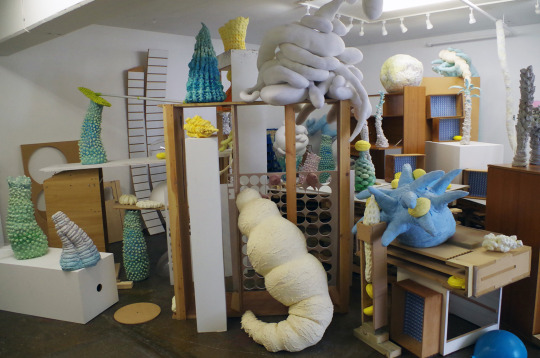
Elly Thomas, ‘Kits and Building Blocks- Stage 1’, 2016. A collection of sculptures and found objects used as a kit of forms with which to improvise and experiment during a solo show at ASC Gallery. Mid-show the installation was dismantled and reconfigured. Papier-mâché, silicone and found objects. Image courtesy of the artist.
You create 'kits' of forms, which can then be assembled freely into a multitude of further configurations. What is it about this performative and non-static form of object creation that is so important to you?
This follows on directly from an animistic engagement with material. This particular form of engagement with matter had suggested that the landscape of play continues to age, evolve and develop throughout adult life. From here I asked ‘How can one treat sculpture and drawing as if they’re ‘toys’ as much as ‘art?’ So getting away from thinking in terms of a finished object or working towards a pre-visualised image, but instead finding a range of ways to experiment with these objects to see what they do, rather than the making existing as an end itself. So for me, making objects is just stage one. After this they become toys that are allowed to ‘live’ through endless reconfiguration.
The objects you make take on biomorphic forms, and seem to me to be suggestive of the domestic. Does this reading of them ring true?
It’s less about the domestic and more about the world of mass production set against the biological world. I’m interested in confusions between the two realms. This exists in childhood (after all what is a toy if not a man-made object that is confused with the living world), and in fact the pioneering child psychologist Jean Piaget asserted that children are often unable to distinguish between the mechanical and the biological – for children where there is movement there is life.
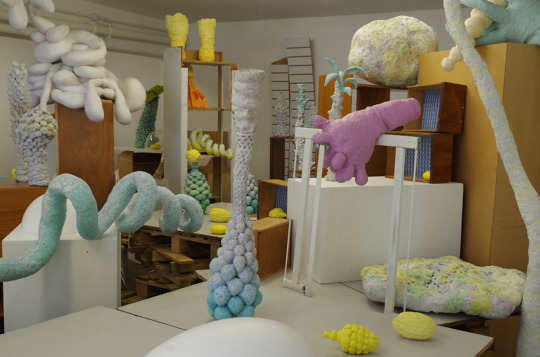
Elly Thomas, ‘Kits and Building Blocks- Stage 1’, 2016. Papier-mâché, silicone and found objects. Image courtesy of the artist.
I explore this confusion through parallels between the biological and manmade that centre on the functional – on engineering, living systems and potentially infinite structures comprised of a simple series of building blocks. This focuses on repetition and symmetry in the world of mass production as opposed to organic repetition (where no repeated form is identical) and organic asymmetry (anything that grows will inevitably be asymmetric).
However, I think you have hit on something about the domestic and the biomorphic, because both my parents are biologists and on the walls of my childhood home there were many reproductions of images from D’Arcy Wentworth Thompson’s book ‘On Growth and Form’. The landscape of childhood would seem to be re-emerging again! So, as is often the case, other people are able to see what you’re doing more clearly than you are yourself!
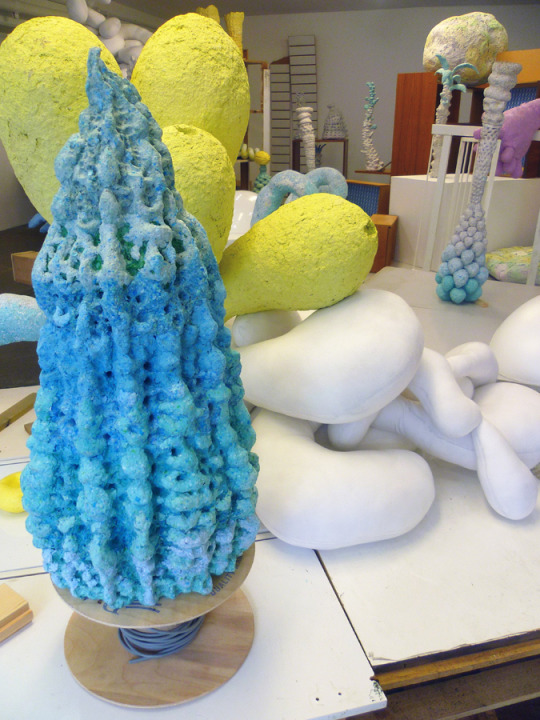
Elly Thomas, ‘Kits and Building Blocks- Stage 1’, 2016. Papier-mâché, silicone and found objects. Image courtesy of the artist.
What is your approach when initially coming to make these forms? How much do traditional considerations of form, material, texture and colour influence the outcome?
Everything comes from collecting. I collect images, objects and junk with no idea how things are going to come together (play is by definition open-ended). I’m also continually sketching, but allow myself to forget the source material the images are based on. This drift allows the forms to gain an independent identity, rather than be left locked in the world of representation. When it comes to moving the forms beyond the sketchbook and into sculpture I choose materials that will force time and change to be built into the process. I want the resulting forms to have ‘grown’ through a response to gravity and changing conditions. The sculptures then exist in physical time - time as layering, stacking and etching.

Elly Thomas, ‘Kits and Building Blocks- Stage 2’, 2016. Papier-mâché, silicone and found objects. Image courtesy of the artist.
You have written extensively about the practices of Philip Guston and Eduardo Paolozzi. You have a forthcoming book for Routledge titled, 'Play and the Artist’s Creative Process: The Work of Eduardo Paolozzi and Philip Guston'. What is it about their individual practices that so interests you? How much influence has your research into their working methods had on your own?
I was initially drawn to their work through their particular relationship with popular culture. Both artists seemed to have engaged with pop culture in a way that didn’t seem to fit into existing art historical labels (even if Eduardo Paolozzi is often described as the Father of British Pop Art, an epithet he first courted and then dismissed).
I began making comparisons between the cultural landscape of their individual childhoods and the work they made during artistic maturity. In the case of Paolozzi one could see a striking connection to toys that would have been available to him as a child, with Guston there is obviously a connection to the comic strips he loved as a boy. But more significantly, as I dug deeper I began to discover that both artists had a recurrent interest in animism and a need for the unexpected outcome.
From here I began to explore their studio methods and processes through the lens of play. Both artists have made a big impact on my work in terms of expanding the possibilities for play within a studio environment. Paolozzi and Guston were endlessly experimenting; they offer artists a vast tool kit of methods that allow one to reconnect with the landscape of play.
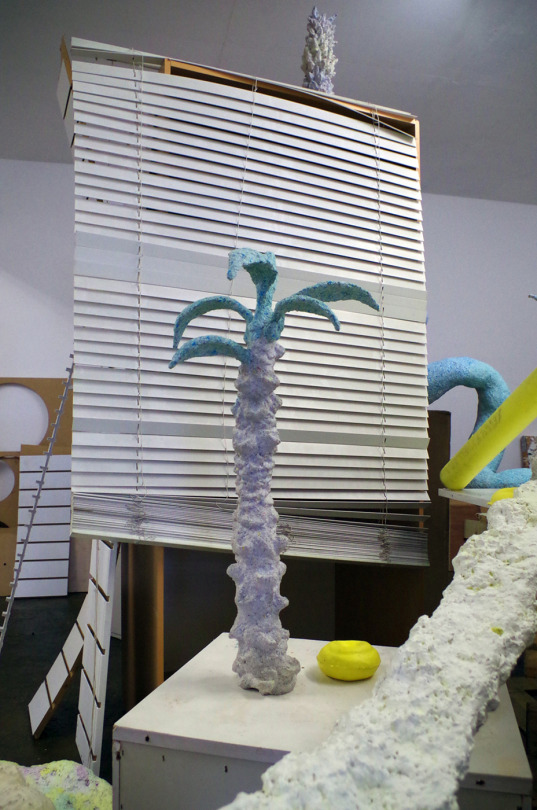
Elly Thomas, ‘Kits and Building Blocks- Stage 2’, 2016. Papier-mâché, silicone and found objects. Image courtesy of the artist.
Your sculptural work has recently been transformed into a 2D, static image for London Arts Board. It is an unexpected and intriguing departure for this facet of your output, transposing its normal mutability into something fixed, especially considering drawing seems to be such an integral element of your practice. How did this come about?
The London Arts Board is an innovative public arts project founded and run by Liberty Rowley on a notice board on Peckham Road. In the current climate with drastic cuts to arts funding and creativity and play pushed to the margins of the school curriculum, public art seems more important than ever. I think in many ways the ‘where’ is the most urgent political question for art – how one makes space to assure that access to the arts is available for everyone.
As to the static nature of my new work – I don’t see the piece as finalised, in a sense it’s on pause until the sculpture elements are reconfigured. In fact I’ve already been playing with different combinations of the elements in my studio. Philip Guston described his paintings as ‘pauses’ and imagined all his paintings as one work. I find that a very potent idea.
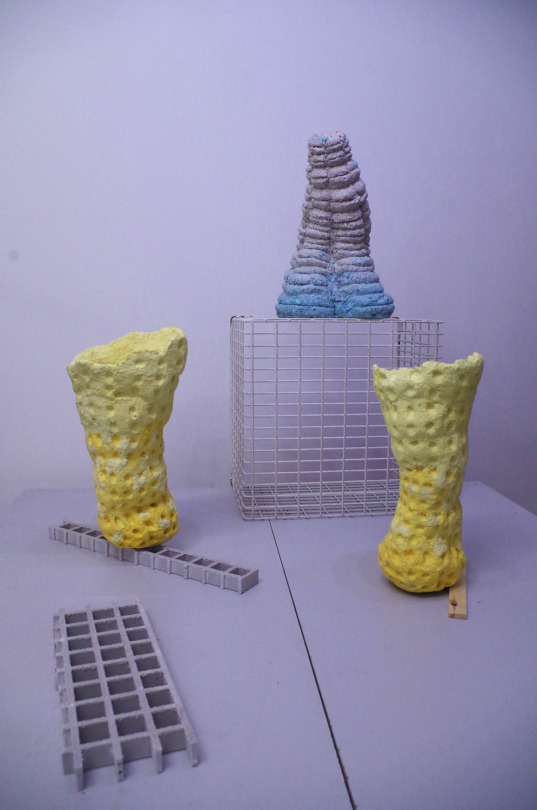
Elly Thomas, ‘Kits and Building Blocks- Stage 2’, 2016. Papier-mâché, silicone and found objects. Image courtesy of the artist.
What have you got coming up?
In mid-February an Eduardo Paolozzi retrospective opens at The Whitechapel Gallery. I’ve been working on the catalogue both as a contributing author and researcher. I’ll also appear in a short film discussing Paolozzi’s print suite General Dynamic F.U.N.
Interview by Charlotte Barnard.
You can see Elly’s work for London Arts Board online at http://londonartsboard.blogspot.co.uk/
You can also see it in person at the corner of Peckham Road and Vestry Road, Camberwell, London.
To see more of Elly’s work and to keep updated with her upcoming events, please follow http://www.ellythomas.com
#Elly Thomas#animism#play#growth#form#eduardo paolozzi#philip guston#LondonArtsBoard#ASC#drawing#biologocal#biomorphism#routledge#contemporary art#emerging art#slade#mass production#mechanical#childhood#sculpture
1 note
·
View note
Quote
I want the resulting forms to have ‘grown’ through a response to gravity and changing conditions. The sculptures then exist in physical time - time as layering, stacking and etching.
Elly Thomas
#sculpture#artist quotes#time#play#animism#contemporary art#process#form#assemblage#drawing#guston#paolozzi#images#object#mechanical#biological#childhood
3 notes
·
View notes
Text
140. Jenny Eden
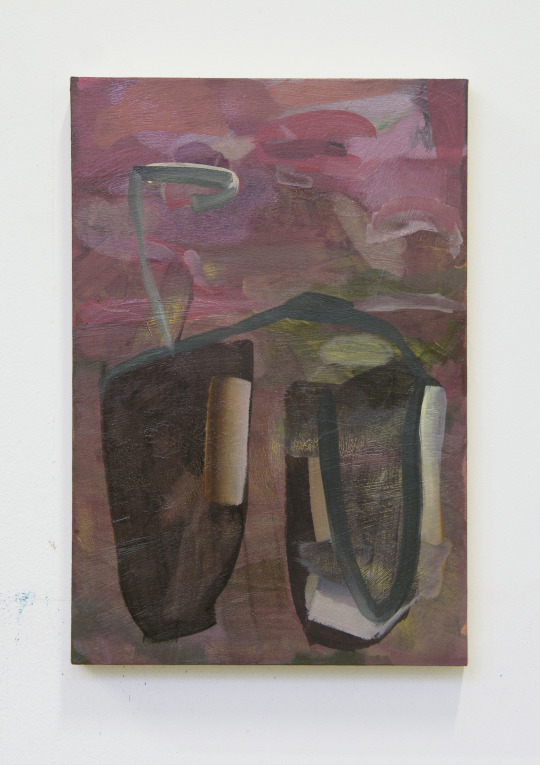
Jenny Eden, Dark business, 2016. Oil on calico; 37 x 25 cm.
Jenny Eden talks to Susie Pentelow about recent shifts and developments in her painterly practice.
At first glance, your paintings appear abstract, but closer inspection suggest fragments of a landscape or scene - I am thinking of works like ’Skip to the middle’ and ’Tengle’, which make me think of plants or stems. How much do you want viewers to understand what they are looking at when they see your work?
David Salle talks about paintings that engage the viewer on their own terms and that good work requires hard looking (Salle, 2015*). I like these words and I agree with Salle. Through the act of looking, I think my work promises something which, as you say, may seem organic. But it’s the place between non-representation and the propensity to find representation that really holds my attention. There are marks in these paintings that could suggest things we know and there are marks that are more ambiguous. It seems to me that as something tangible starts to form in the mind whilst one is looking at one of these paintings, any kind of understanding breaks down. It is at this point that the viewer is faced with the painting alone, not a thing, a place or an occurrence, but something that is about the physical act of painting.

Jenny Eden, Can toy, 2016. Oil on calico; 37 x 25 cm.
This connected to my recent musings about not knowing. I’ve been thinking about the empty space between the mind of the painter and the surface of the painting before marks are made and some sort of potential reveals itself. This is usually a very productive and liminal space and one which Fisher and Fortnum quite rightly say is sought after in the artistic process (2013**). I am really interested in the way that a painting can hold this uncertainty in a state of not knowing, recognising, allowing, remaining and containing in order to facilitate something in the mind of the artist whilst painting and something in the mind of the viewer when looking.
* Salle, D. (2015) ‘Structure Rising: David Salle on ‘The Forever Now’ at MOMA’. ARTNews. March, p44 – 53.
** Fisher, E. & Fortnum, R. (2013) On Not Knowing: How Artists Think. London: Black Dog Publishing.
Previously, your work engaged with tight, geometric forms, whilst recent work suggests a movement toward looser, more gestural marks. Has this been a shift in your practice?
Absolutely. As you suggest, my previous work dealt with spatial concerns using solid colour against an intensely worn or worked surface and often took months to realise. Having developed a body of work over a number of years I was ready for an injection of criticism and attention in the form of postgraduate education. Since September 2015 I have been studying for an MFA at Manchester School of Art, which has challenged my practice more than I could imagine.

Jenny Eden, The shed, 2016. Oil on canvas; 37 x 25 cm.
A useful lesson at the beginning of the MFA was to confront any habits that had set in. So I immediately started to make a painting in one go, which allowed for an immediacy I had not experienced as intensely before. I also decided to put both the hard edge and solid colour to one side and concentrate on developing a language of mark-making and gesture. The work has since grown in both robustness and significance and I am now dealing with painting from a deeper understanding of facture and index. The paintings are now constructed through what I call sittings; layers of activity (made in one go or sitting) that connect or react. And I’m particularly interested in reworking a painterly approach to depth and illusion in my work. Rather than using a perspectival tool to determine the nature of a recession, I want to create depth through a series of flat planes of painting activity. In doing this, marks can protrude and recede independent of their size, fabrication or colour.
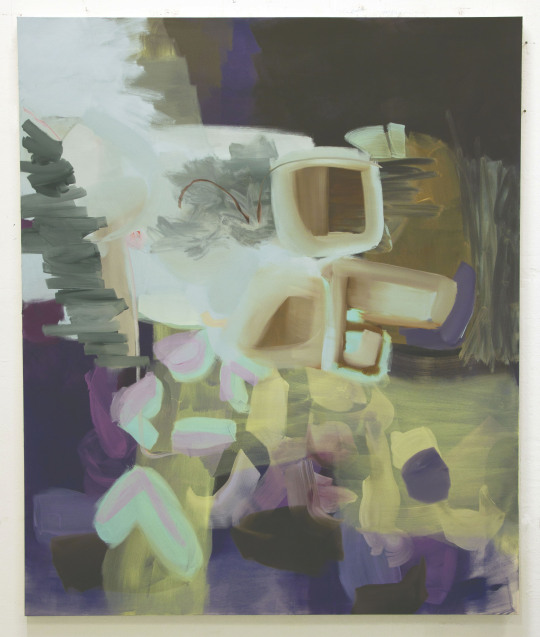
Jenny Eden, Bertie's the one, 2016. Oil on calico; 1.8 x 1.5 m.
Your titles are very intriguing - what role do they play?
I used to have a hard time titling work, but the recent work has instigated another shift. Each painting is autonomous, existing by itself and for itself, and probably for this reason titling can be a very interesting and enlightening process for me now. In these paintings, the title plays something of an addendum-like role. It is not a way of understanding the painting, but acts like another sitting or layer of activity at the end of the doing part. Immediately after making a painting, I usually give it a pet name - often something quite ridiculous - as a reference. Sometimes the real name comes from this, or if the pet name is impractical I try to be more serious! In some cases the title of the painting functions in the same way as the painting itself; it almost makes sense but not completely.

Jenny Eden, Wangling wangle, 2016. Oil on calico; 37 x 25 cm.
Is there an artist, living or dead, who has been particularly influential for you?
I guess my answer to this question has to be Agnes Martin. I melt to the subtle and monochromatic qualities in her paintings, but what attracts me more so these days is her approach to making work. Martin asks the painter to listen to their mind and search for the thing that appeals to them in order to pursue potential and shed the rest (Martin, 2004*). I cannot help but follow this guidance like a mantra, because it really works for me. It’s about achieving a kind of meditative state to maintain the practice of painting and, like Martin, really get in touch with the work. I have realised that I need a mental quietness before, during and after making work. I also need to let the paintings breathe, as I do. They also gain experiences. In a rather odd and sort of confrontational way, it is as if they need to have fight in their bellies to survive and be something. For me, this certainly comes back to the autonomy of the painting.
* Liesbrock, H. & Martin, A. (2004) ‘The Islands’. Düsseldorf: Richter Verlag.

Jenny Eden, Bean, 2016. Oil on calico; 37 x 25 cm.
What do the next few months have in store for you?
Initially, I have an exhibition at Cornerstone Gallery, Liverpool Hope University, with the sculptor Polly Tomlinson from 13 January to 1 February. I then plan to make more work. I have been painting at 1.8 x 1.5 metres recently and I am working through the process of translation something from the smaller scale to the larger scale. This is revealing new concerns about flatness and places of painterly activity on the canvas. I am also looking forward to the MFA show in September / October this year and I have plans to be involved one or two group shows between now and then.
I am keen to understand my practice in the context of both contemporary painting and contemporary writing and I will be continuing to research and write on themes that are close to my practice. As a painter, who writes, I feel I am able to shed a different light on painting from inside its physical activity, and this really excites me.
Interview by Susie Pentelow.
You can see work by Jenny Eden and Polly Tomlinson at Cornerstone Gallery, Liverpool Hope University from Friday 13 January to Wednesday 1 February, with a preview on Wednesday 25 January from 6-8 pm. For more information, visit www.hope.ac.uk/cornerstonegallery.
To find out more about Jenny Eden’s work, visit www.jennyeden.co.uk.
#Jenny Eden#painting#wiring#Agnes Martin#Cornerstone Gallery#Polly Tomlinson#colour#process#form#artist#interview#Liverpool#Manchester#MFA#Manchester School of Art#practice#contemporary art
1 note
·
View note